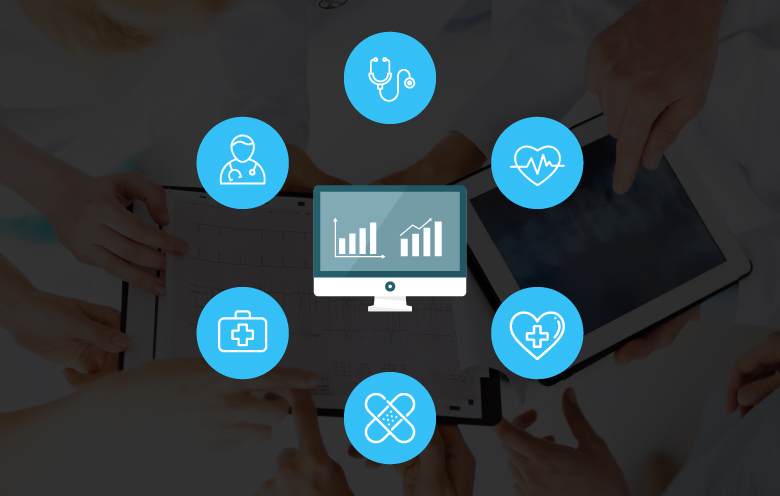The healthcare industry is undergoing a massive digital transformation, much of which is related to the ways in which data is being captured and used. Organizations are collecting data from numerous sources like clinical notes, lab results, insurance claims, drug prescriptions, wearable devices, and healthcare management systems. The scale of this data is increasing rapidly and is expected to increase by around 48% annually (Stanford University report). Despite having such an enormous amount of data, healthcare providers are yet to realize its true potential. By placing more emphasis on healthcare data analytics and business intelligence programs, this sector can better harness data.
Challenges in healthcare data
BI offers immense opportunities to improve patient outcomes, deliver precision medicine, minimize costs, reduce hospital readmissions, maximize revenue, ensure patient safety and abide regulations. But, there is an equal amount of obstacles in implementing predictive analytics in healthcare which need to be addressed:
Data security
Securing patient data is a priority of all healthcare organizations as cyber-attacks in this industry are increasing rapidly. HIPAA specifies around 18 elements of personal health information (PHI) that must be protected. The challenge is to remove these core PHI elements and still make data useful for analysis. This regulation also mentions some safeguards, which organizations must follow in order to ensure patient privacy and security. Balance is required between addressing data privacy and using patient data for invention and research.
Data quality
The larger part of healthcare data is unstructured and is available in the form of text, images, numeric, paper, audio and visuals. This unstructured and untapped data usually contains the most crucial and groundbreaking information regarding patients, staff, and performance. Current EMR systems focus majorly on financial data and are being used mostly for legal records. The challenge is to make these EMR systems more resourceful and interoperable where doctors can find transactional data related to patient care and use it to glean meaningful insights.
Data sharing
To develop better health initiatives and patient outcomes, clinical data needs to be shared across various organizations like hospitals, research centers, pharmacies, and more. But with data sharing comes along data privacy issues. Therefore, it is important to keep the HIPAA regulations in mind in order to share the information in a secured manner. The other major challenge regarding data sharing is there is no universal approach to data storage, which makes it difficult to achieve interoperability with other medical data management systems.
Cross-domain and consolidated analysis
To improve the effectiveness of the healthcare services offered, it is often required to combine data coming from different sources and consolidate them together to get a unified view. For example, to get overall information regarding any patient, you need to go through his/her medical records, purchasing history to know about drinking and eating habits, wearable data for exercise patterns, and more. The legacy tools used by most of the medical centers lack in providing cross-domain analysis of the data collected.
Technology adoption
Medical organizations are collecting huge amounts of data on a daily basis, but it cannot be used until they have the right infrastructure, technology and, tools. Often healthcare centers lack in having the right technology, which can support their data analytics efforts. Though large companies in healthcare are rapidly adopting new technologies like smart devices, mobile computing and, cloud computing, it is time for small and mid-sized healthcare providers to adopt the same. Moreover, there should be innovation in not just technologies related to patient care but the ones that focus on business systems as well.
How a well-structured BI program helps to overcome these challenges
Healthcare organizations can effectively overcome these obstacles by developing a BI program. There are already a number of BI and data visualization tools available in the market, which you can always start with. However, if you wish to reap long terms benefits, it is advisable to have a clear BI roadmap and strategy.
The need of every healthcare organization is different; some might require a full-service deployment while others may need specific cloud-based solutions or a combination of both. Tableau, SAP BusinessObjects, Power BI, Domo, Qlik, Oracle Business Intelligence, Sisense and TARGIT are among some of the popular BI tools used in the healthcare industry. But, before you choose the tools, be clear with what you want to achieve through this BI program.
Here are a few things to keep in mind while formulating a BI program as they help you to overcome major data-related challenges:
- Try to develop a centralized business architecture that is capable of keeping all major PHI hidden, while still allowing to carry out analysis.
- Incorporate technologies that help your organization to extract value from unstructured data, in order to provide better data-backed analysis.
- If your analysis requires combining data from multiple EMR systems, then select the business intelligence tool accordingly.
- Stay informed of the various data sources that your organizations need to improve the decision-making process. Choose the right tools, which can connect these multiple data streams and deliver insights.
- By using modern BI tools, you can leverage effective security measures to keep your patient and organizations data safe. This helps to build and maintain trust, which encourages individuals to share their personal health-related data. The more data you have, the more power you have to make informed decisions.
- Take account of all the different user groups like analysts, administrators, executives, doctors and developers who need access to these business-related insights. Your BI strategy must be able to keep their considerations in mind and provide them with fact-based results.
- Outline the kind of dashboard and reporting features that will go in accordance with your organizational needs. Once decided, start looking for tools that offer these features.
Final say
Having the right business intelligence strategy for your healthcare organization will help you realize the benefits of medical data. In order to build a strategy that answers your specific needs, it is best to consult an expert. At Softweb Solutions, we provide unique BI and data visualization solutions to healthcare and other industries depending on their requirements. If you want to develop a BI strategy for your organization, contact us.









